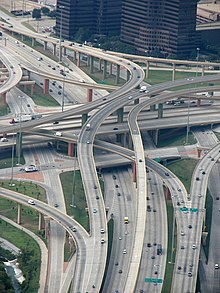Connection ramp

A connecting ramp is the road that enables the transition from one road to the other in the case of unevenness (plan-free) traffic junctions such as motorway junctions , motorway triangles or motorway bifurcations .
Depending on the design and objective of the junction, different variants of connection ramps are used, which are decisive for the designation of the design of a junction. In addition to traffic volume and costs, security is also an aspect for selection. So z. B. avoided tight curve radii, but the traffic should not be slowed down by an exit beforehand. The indirect connecting ramp is therefore rarely used in road triangles.
Ramp groups
When considering connection ramps, a distinction is made between two different groups of ramps.
- Ramp group 1 - connection between two unplaned streets
- Ramp group 2 - connection of an unplaned street to a subsequent street with the same level
Direct connection ramp
There is a direct connection when there is no need to cross or cross any other lane. Direct connection ramps, also known as tangential ramps or tangential lanes, are only possible when turning right (when driving on the left, only when turning left) and are present at all common forms of intersections. Since no bridges have to be built and it is possible to drive through at high speed, there is no sensible alternative to turning right.
In the case of non-adapted tangents, the ramp runs in a uniform 90 ° curve, while in the case of an adapted construction the course of another ramp is followed. The adapted shape saves space, but forces you to reduce the speed. Therefore, this variant is only selected if the space available does not allow for an unadjusted ramp course.
Semi-direct connection ramp
Semi-direct is a connecting ramp for turning left (when driving on the right), which crosses or crosses both motorways. As with the direct connection ramp, high speeds are possible, but depending on the route, one or two less complex bridge structures are required. This shape requires a lot of space if the traffic flow is to be slowed down as little as possible, since large curve radii are necessary. The bridges also make it expensive.
It is usually only used when the connected motorways have high traffic density. It is more common in motorway triangles than at motorway junctions in order to slow down the main flow of traffic as little as possible. The course of a semi-direct connection ramp depends essentially on the type of junction.
Indirect connection ramp
With the indirect connection, which is used to turn left, in contrast to the semi-direct variant, no additional bridge structure is required. It usually runs within a direct or semi-direct connection ramp, which means that the space requirement is very little. However, the flow of traffic is severely slowed down by the tight curve radius.
This shape, which is also known as a “loop” or “ear” (hence the name loop ramp), is mainly found at motorway junctions in the shape of a clover leaf or motorway triangles in the shape of a trumpet. It is the most common design for turning left at intersections in Germany. In heavily frequented connections it is increasingly being replaced by a semi-direct connection ramp.


